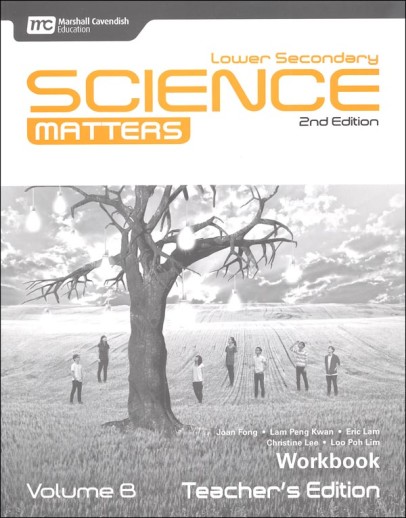We use cookies to make your experience better. To comply with the new e-Privacy directive, we need to ask for your consent to set the cookies. Learn more.
Lower Secondary Science Workbook Teacher Edition Vol. B
Items listed in this section tend to be complete science programs with a teacher and student component, requiring few supplements besides science supplies.
Developing a keen appreciation and understanding of science will open doors for our children as they reach their adult years, not only in the sense of being scientifically minded in our technological society, but also through a curiosity and appreciation of the world around them along with enhancing the development of critical thinking skills.
Written to meet the 2013 Lower Secondary Science syllabus from Singapore and distributed by Singaporemath Inc., this new science series will engage children as they develop scientific literacy. Designed to meet the needs of diverse students, the series has been written for academically advanced (express) students as well as those considered "at level" (normal) students. While it is possible to use the textbook independently, the workbook is considered integral to the program, and students will also gain a greater depth of study through the additional supplemental materials available.
The Science Textbook is the heart of the program and helps students discover scientific knowledge through real-life context. Each chapter begins with a theme opener which focuses on relating the core concept to everyday life. A chapter opener follows which provides a high interest topic and key questions that work to form the framework of the chapter. Individual sections offer a real-life context designed to uncover scientific concepts. Also included are "Think and Explore" questions applying concepts to new situations and "Scientists at Work" which serves to highlight the contributions of famous scientists. Key concepts are summarized through a concept map, and review questions are provided in three levels of difficulty. One impressive aspect of this textbook is the "Science Today" section which focuses on 21st century concerns to enhance critical and inventive thinking skills, communication skills, global awareness, civic literacy, and cross cultural skills. Written from a religiously neutral perspective, there is no evolutionary content within this series.
The Workbook provides several worksheets corresponding to each chapter in the textbook as well as two thematic reviews. Questions focus on recall and application of concepts as well as connecting concepts. Graphic organizers, challenging questions and real-life application are all used to reinforce learning. The Teachers Edition of the Workbooks contains copies of the student pages with answers. No additional teaching support is included. Non-reproducible.
The Practical Books provide the hands-on experiments for the program. Activities are introduced with real-life context and provide clearly drawn illustrations, step-by-step instructions, and discussion questions. While designed for schools, it may be adapted for homeschool use. Publisher modification suggestions include using chicken eggs to observe osmosis instead of a quail egg and forgoing the Bunsen burner. It is also possible to omit some of the experiments. Please call for a complete list of supplies. Worth noting is that some of the experiments involve "field trips" which reference Singapore locations. It may be possible to find a local place to visit or utilize the internet for a similar field trip experience. All measurements are in the metric system. The Practical Book Teachers Edition is a student edition with answers. No additional teaching support is included.
The Structured Questions Book is an optional tool designed to expand a students scientific knowledge. Questions involve knowledge recall, higher level thinking skills and application. A final paper is incorporated as well. Exam tips are scattered throughout topics and detailed answers to all the questions are provided. Non-reproducible.
Together, Levels A and B are designed to cover two years of science. In Book A, students cover Science and Technology, Diversity and Models. In Diversity, students explore the diversity of matter through physical properties, chemical compositions, separation techniques and a close look at biodiversity. In the thematic unit on Models, students explore cells as the basic units of life, the particulate nature of matter, atoms and molecules, and light. Book B themes are Systems and Interactions. In Systems, transport systems are covered including human and plant. It also covers the human digestive system, human sexual reproduction, and electrical systems. Please note the section on human sexual reproduction includes teaching on premarital sex, abortion, birth control and sexually transmitted diseases. In the Interactions section, topics covered are application of forces, energy, vibrations/sound, heat and its transmission, chemical changes and ecosystems.
Comprehensive and engaging for the Jr. High student, this series offers homeschool families a fresh approach to the sciences, although I would like to see a homeschool-friendly Practical Lab component. All books are soft-cover.
| Product Format: | Paperback |
|---|---|
| Brand: | Marshall Cavendish |
| Grades: | 7-8 |
| ISBN: | 9789810117450 |
| Length in Inches: | 10.75 |
| Width in Inches: | 8.5 |
| Height in Inches: | 0.25 |
| Weight in Pounds: | 0.75 |

